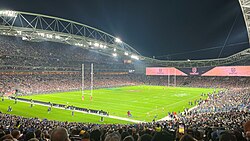Accor Stadium | |
 The stadium during the 2022 NRL Grand Final | |
 | |
| Former names | Sydney Olympic Stadium (1999–2001) Stadium Australia (2001-2002, 2020–2021) Telstra Stadium (2002–2007) ANZ Stadium (2008–2020) |
|---|---|
| Location | Sydney Olympic Park, New South Wales, Australia (Map) |
| Coordinates | 33°50′50″S 151°03′47″E / 33.84722°S 151.06306°E |
| Public transit | |
| Owner | Venues NSW via Government of New South Wales |
| Operator | VenuesLive Management Services |
| Capacity | 82,000 (Rectangular)[2] 81,500 (Oval) 115,000 (2000 Summer Olympics) |
| Record attendance | 114,714: 2000 Olympics closing ceremony |
| Field size | 160 m × 118 m (525 ft × 387 ft)[3] |
| Surface | Grass |
| Construction | |
| Broke ground | 12 September 1996 |
| Opened | 6 March 1999 |
| Construction cost | A$690 million[1] |
| Architect | HOK Sport |
| Tenants | |
|
New South Wales Blues (State of Origin; 1999–present) Australia national rugby union team (selected matches) New South Wales cricket team GWS Giants (2012–2013; 2022–present) Australia men's national soccer team (selected matches) Australia women's national soccer team (selected matches) Sydney FC (selected matches) | |
| Website | |
| accorstadium.com.au | |
| Ground information | |
| End names | |
| Eastern End Western End | |
| International information | |
| First T20I | 1 February 2012: |
| Last T20I | 9 November 2014: |
| First WT20I | 1 February 2012: |
| Last WT20I | 9 November 2014: |
| As of 12 August 2023 Source: Cricinfo | |
Stadium Australia, currently known as Accor Stadium for sponsorship reasons, is a multi-purpose stadium located in Sydney Olympic Park, a suburb of Sydney, New South Wales, Australia. The stadium, which is sometimes referred to as Sydney Olympic Stadium, Homebush Stadium or simply the Olympic Stadium, was completed in March 1999 at a cost of A$690 million[1] to host the 2000 Summer Olympics.[4][5] The Stadium was leased by a private company, the Stadium Australia Group, until the Stadium was sold back to the NSW Government on 1 June 2016 after NSW Premier Michael Baird announced the Stadium was to be redeveloped as a world-class rectangular stadium. The Stadium is owned by Venues NSW on behalf of the NSW Government.
The stadium was originally built to hold circa 115,000 spectators, making it the largest Olympic Stadium ever built[6] and the second largest stadium in Australia after the Melbourne Cricket Ground which held more than 120,000 before its re-design in the early 2000s. In 2003, reconfiguration work was completed to shorten the north and south wings, and install movable seating. These changes reduced the capacity to 80,000, with the capacity to add seating depending on the venue configuration. Awnings were also added over the north and south stands, allowing most of the seating to be under cover. The stadium was engineered along sustainable lines, e.g., utilising less steel in the roof structure than the Olympic stadiums of Athens and Beijing.[7]
- ^ a b Cite error: The named reference
anzstadwebwas invoked but never defined (see the help page). - ^ "Accor Stadium". Austadiums. Archived from the original on 2 November 2023. Retrieved 2 November 2023.
- ^ Atkinson, Cody; Lawson, Sean (15 June 2022). "From the SCG to Kardinia Park — do ground sizes contribute to the end result in AFL games?". ABC News. Australian Broadcasting Corporation. Retrieved 19 February 2024.
- ^ Cite error: The named reference
mediawatch99was invoked but never defined (see the help page). - ^ Cite error: The named reference
abspresswas invoked but never defined (see the help page). - ^ "Biggest stadium in the world". olympics.com. Archived from the original on 6 December 2022. Retrieved 30 December 2022.
- ^ Stadia: Structural Giants Archived 2 October 2011 at the Wayback Machine Ingenia Magazine, March 2005